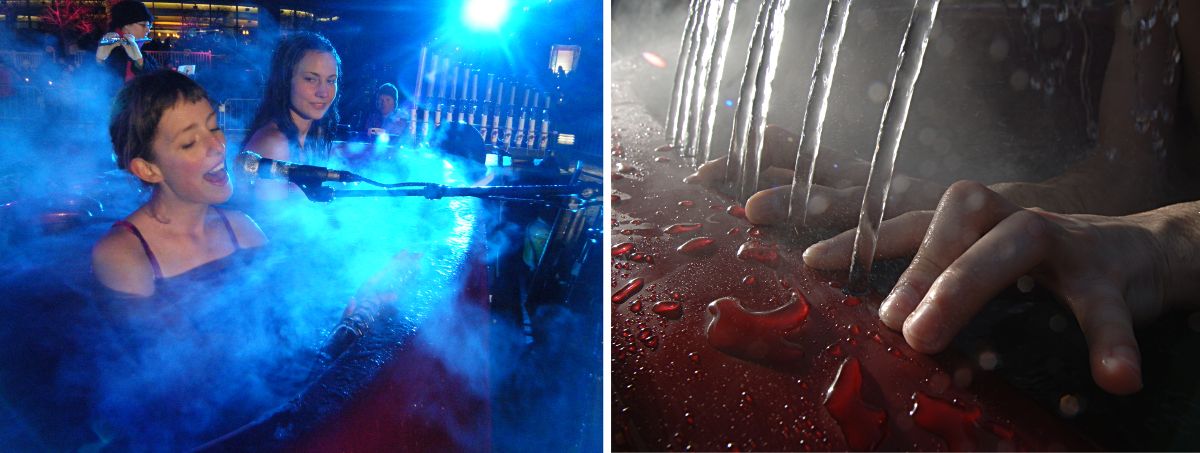
(H2Orchestra was the main act for Winterlude 2010 for the National Capital Commission.)
I do not claim that this is a plan for a water centre, because the plan and overall vision for the water centre is the job of others, such as the Ladies of the Lake, etc..
Something bothered me about the way she put these three sections at the same level, while, right behind her, I could see the piano -- an instrument that is both strings and percussion -- that she played every morning. And its not like the piano was some rare exception to the strings-percussion-wind division. The piano is in fact the world's most popular instrument.
Thus I thought, for a moment, about what strings and percussion had in common, and it occurred to me that they both make sound from vibrating solid matter, whereas wind instruments make sound from vibrating gas.
So I said that there are really only two sections to the orchestra: solid and gas.
Then I said, "How about a musical instrument that makes sound from vibrating liquid, so that the orchestra would actually have three sections: solid, liquid, and gas?"
The answer was "Don't be silly, liquids can't make (musical) sound!".
I had a dream, as a child, that I was frolicking in a fountain, and that the fountain was a musical instrument that made musical sound (i.e. not just splashing noises, but actual musical tones that could be used to play familiar melodies) when I struck the water with my hands or fingers. The sound had a the clarity and tonal purity of a piano or pipe organ.
I asked various engineers and scientists about this and they all told me it was impossible. But eventually I suceeded in making various prototypes, and H2Orchestra was born, with sound from H2O in its various states as ice, water, and steam.
And we've successfully used these newly invented musical instruments in
public performances:

(H2Orchestra was the main act for Winterlude 2010 for the National Capital Commission.)
Now I've put together a team of researchers, engineers, and scientists
to bring this vision to reality, and
create installations for museums around the world, none of which
is specifically focused on water:
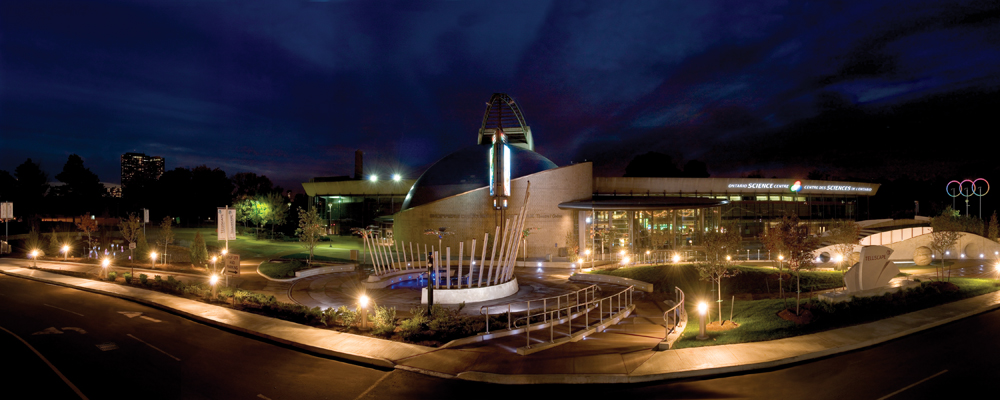
What I think the world needs, however, is a museum or centre, educational facility, or the like, that is specifically focused on water, and it would bring pleasure to my heart to contribute some of my inventions and ideas to such an effort.
Recently the Royal Ontario Museum asked us to be involved in the Water Exhibit, and I've also been in contact with various others working on water exhibits around the world. Our work with water was also selected by the Ontario Centres of Excellence for exhibit at OCE Discovery 2010 and ECE Discovery 2011/Ontario Global Water Leadership Summit, where we had a chance to meet with leaders in the water sector from around the world.
So when I grew up, I built an aquatic play facility on the roof of my house, in addition to equipping every room in the house with the capacity to function as a wet splash and water play area.
Some of the things I learned were new ways of understanding water, and teaching these concepts.
For example, one might exhibit I came up with allows participants to feel the increasing head of water as they walk down a parabolic pathway, stairs, or the like.
Another exhibit uses a glass ceiling water sculpture to teach optical properties of water, using laminar flow, points and ripples of infinite brightness, (caustics), etc..
Another exhibit is a downspout disconnect lab in which the building's drains are used as part of a research facility.
I've also built a faucets lab, a toilets lab, and a showers+baths lab that includes an experimental water-saving shower system that was ultimately presented on Capitol Hill in Washington for use in Washington area hospitals.
I built a water recirculation exhibit that teaches the three valuable properties shower water that should not be wasted: heat, pressure, and cleanliness.
In some sense the building is an aquatic play and research facility, i.e. what I've come to call the "frolic lab".
Thus I think I can bring some unique experience, inventions, and ideas, i.e. I think the water centre could have a "frolic" component to it, where people can understand water from a truly interactive (i.e. "WaterTouch") sense.
I also like to teach the states-of-H2O, namely that H2O is not the same thing
as water. Water is a special case when H2O enters its liquid state-of-matter.
To convey this I designed a musical ice sculpture that melts into water, which
feeds a hydraulophone, after which that water is converted to water vapour
to complete the water cycle with a musical instrument that runs on water
vapour:
| Solid H2O (ice) | Liquid H2O (water) | Gas H2O (steam) |
|---|---|---|
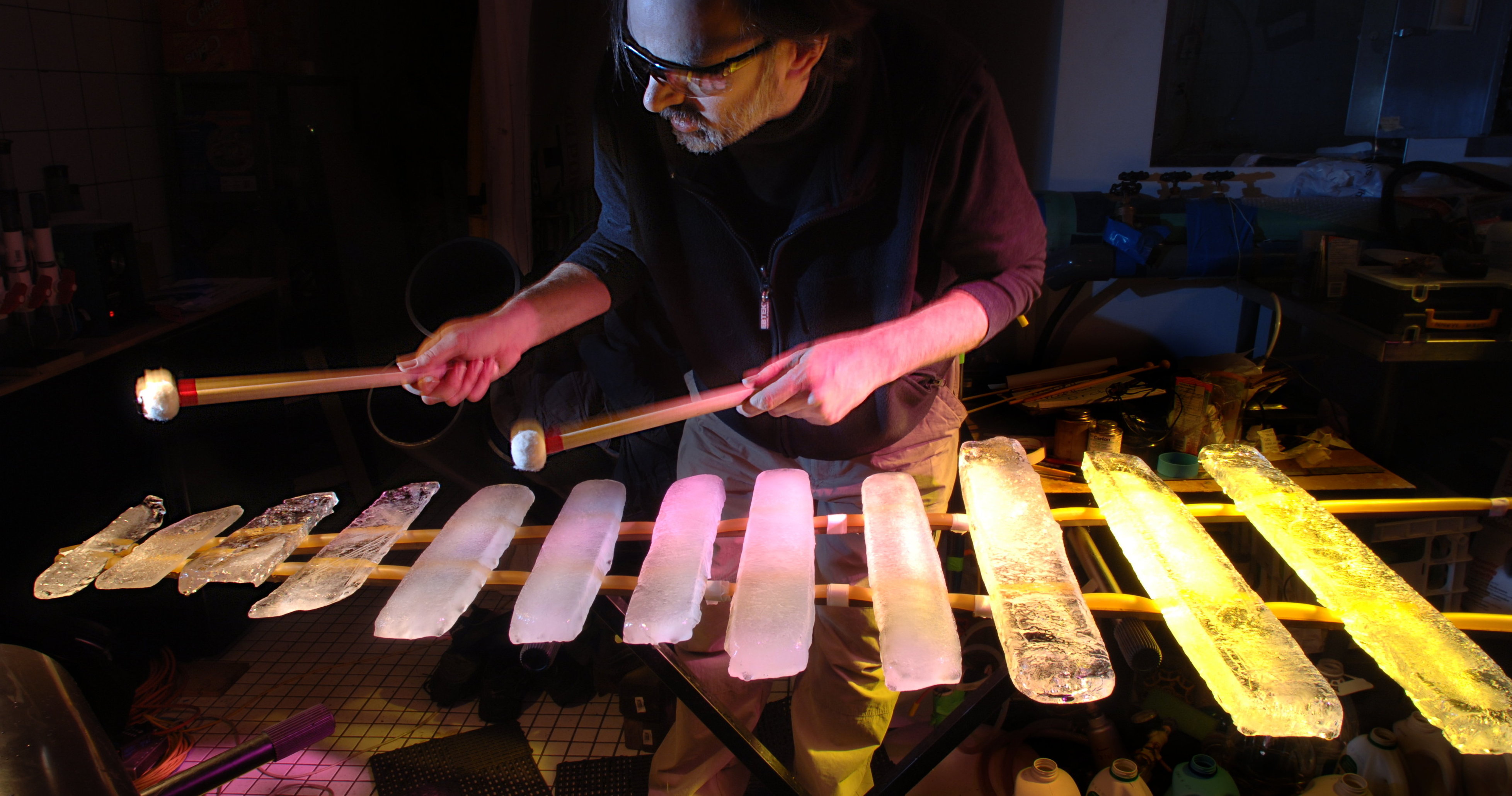
| 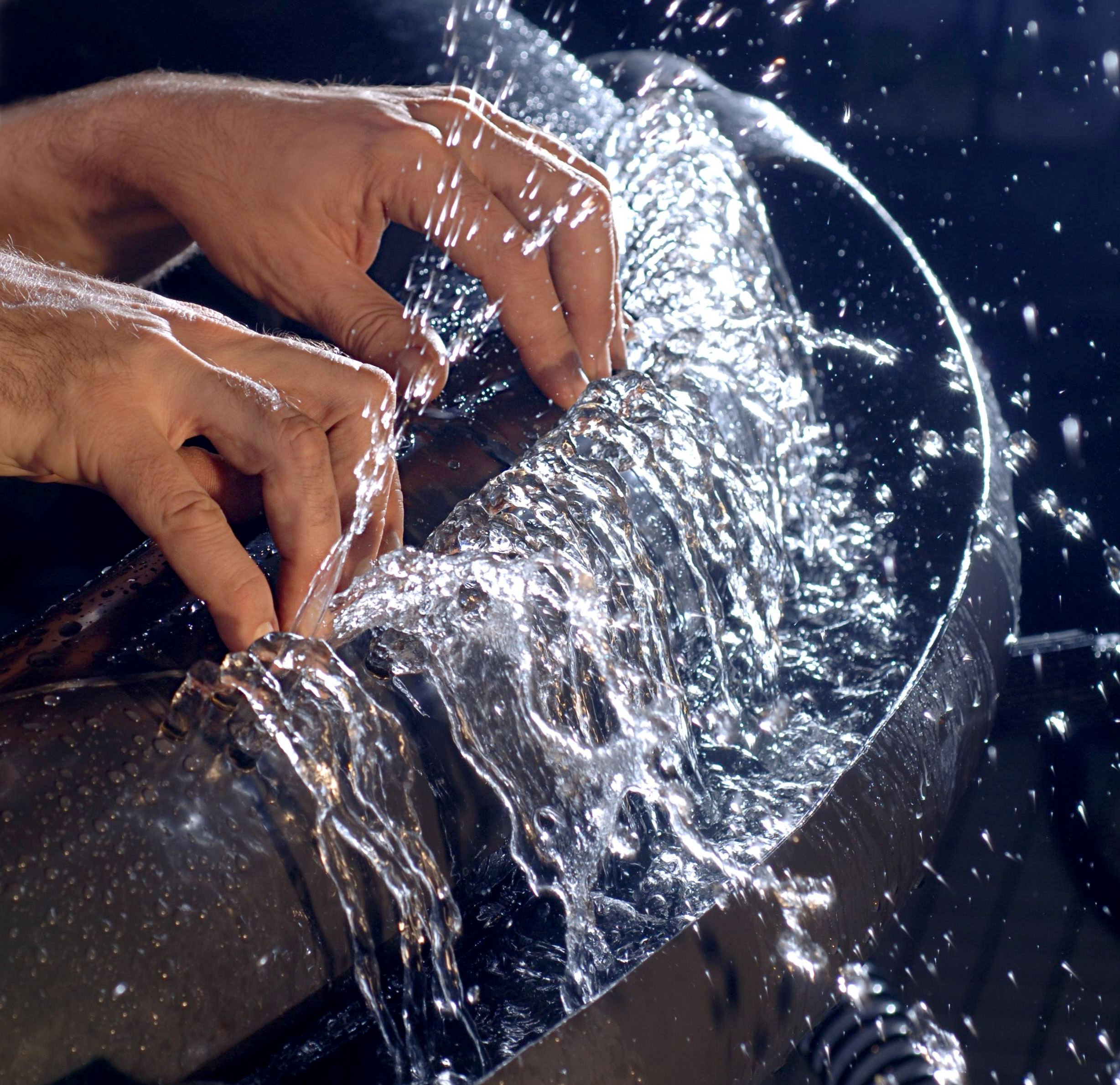 |
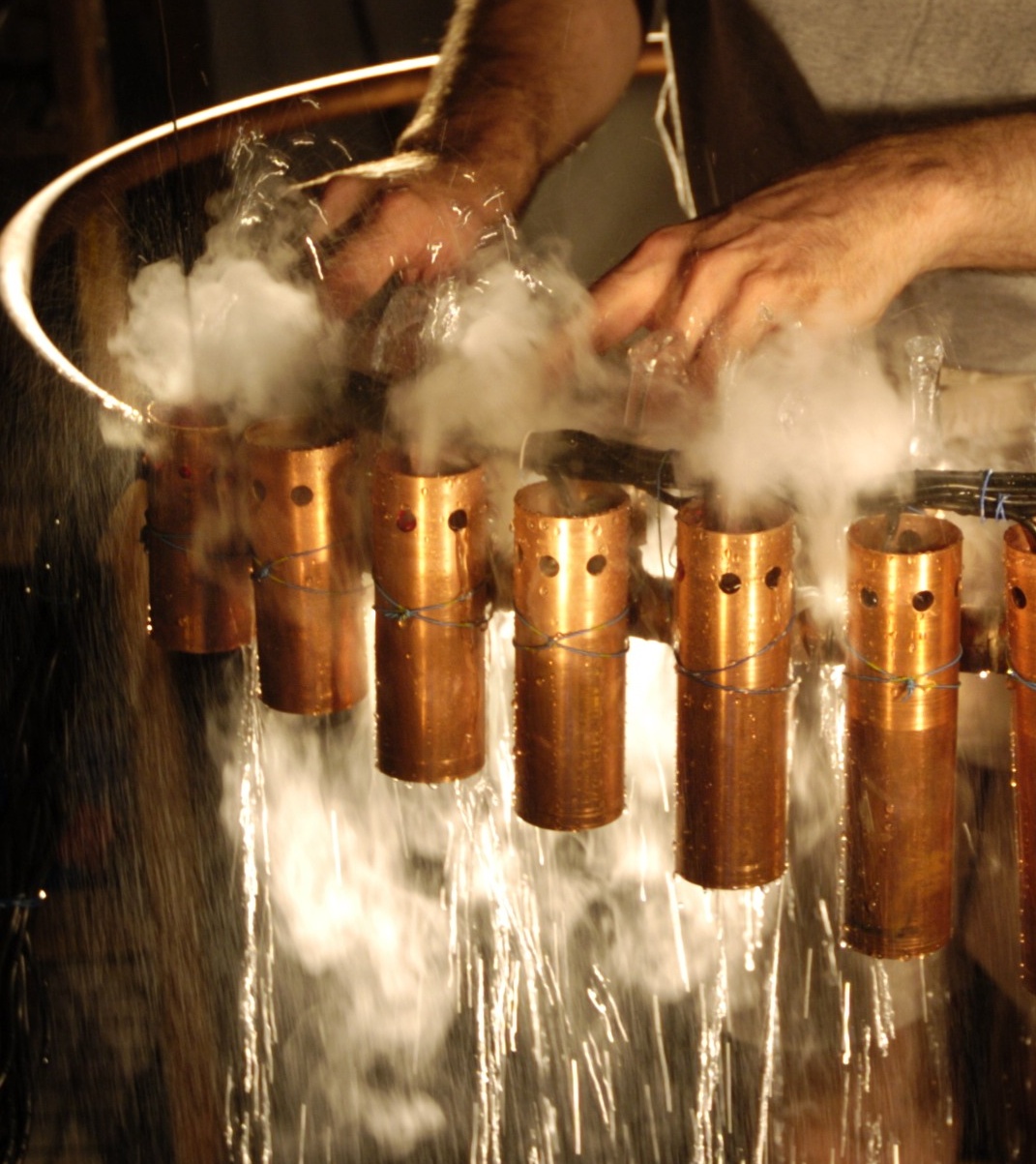 |
| Pagophone | Hydraulophone | Idratmosphone |
We tend to take on a small number of projects and do them very well, putting our full effort into each project, and adapting to needs and wishes presented to us as time goes by.
Accordingly, our technical requirements and scope are flexible.
What has been proposed (initial planning with Doug Pettigrew) is a $10k fee for which we would supply a variety of artistic works, consulting, performing, educating, and the like, for the July 12th weekend. We remain flexible in terms of which works are ultimately desired.
Some of the proposed works include, for example, making Lake Simcoe itself into a musical instrument (i.e. the entire lake as a spacious water instrument of sorts).
Additionally, we can provide the following instruments as performance elements (some or all for a formal Friday evening performance, plus interactive art installations, and an educational Saturday evening performance, event, etc.):
Technical requirements for the 45-jet concert hydraulophone are 10 gallons of water with topup depending on use (typically one gallon per hour of operation), 120 VAC electrical outlet plus 3 microphones, plus two audio-transformer-isolated direct inputs (to connect to hydrophones supplied by us). Setup is minimum 12 hours before performance. Moving the instrument requires approximately the same standards as wheelchair accessibility (ramps, etc.), or may be carried by 6 to 8 people who have previosly practiced moving it. Dimensions of the instrument (without stand, or basin circulatory reservoir, etc.) is shown toward the end of the following page: http://wearcam.org/nessie45/
The 45-jet instrument is only for being played by an experienced hydraulist.
Technical requirements for 21-jet and 12-jet hydraulophones is 5 gallons of water with topup (typically one half gallon per hour depending on use), 12 volts DC or 120 VAC outlet for a battery charger supplied by us, and one microphone plus one audio-transformer-isolated direct input. We can provide a 12 volt power supply that operates from 120 VAC, and we can also provide two solar panels, each of which will operate an 21 or 12 jet instrument when there is natural unobstructed sunlight (e.g. on a sunny day). The 21-jet and 12-jet hydraulophones may be played by participants, and can be used as participatory installations. These hydraulophones are generally to be setup at least 6 hours prior to performance.
Technical requirements for waterhammer piano is 10 gallons of water, plus topup (approx. 1 gallon per hour), and 12 volts DC, or a 120 VAC outlet for a battery charger supplied by us. We can bring a 55 Amp-hour battery that will run the instrument for a couple of hours but a battery charger will help keep the pumps running continuously. The WaterHammer Piano will also run from one of our solar panels. The WaterHammer Piano may be played by participants, and can be used as a participatory installation. WaterHammer Piano setup is generally at least 6 hours prior to performance. The WaterHammer Piano has a roll cart (four 10-inch pneumatic wheels).
The technical requirements of the balnaphone are as follows: 125 gallons of water plus topup (approx. 1 gallon per hour), and a standard stove outlet (40 amp range receptacle, 208 volts with neutral, or 240 volts with neutral). The balnaphone can also be fitted with a standard 3phase L21-20 or L21-30 plug for 208Y/120V connection (3phase with neutral), and will run at 20amps, but preferably 30amps.
The balnaphone has a steel-frame with six 10-inch pneumatic wheels. It weighs approximately 250 pounds empty and approximately 1500 pounds when filled with water (125 gallons). It can be rolled along while full, but only on smooth and level surfaces. Typically it is rolled into place empty then filled, and started up. We supply a pump that can empty it in two minutes (typically into a garden or other area of your choosing).
Balnaphone setup is generally 24 hours prior to performance.
For the balnaphone, we would need to book a balnist far in advance of the event, and provide for rehearsals, and the like, leading up to the event.